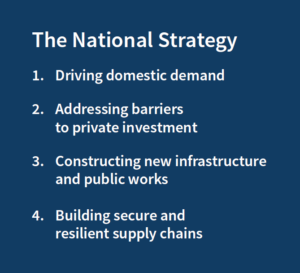
To Help Reverse Soaring Inflation, Invest in Clean Energy
America has once-in-a-generation opportunity to lower energy costs and establish global leadership on climate and clean energy by focusing on regional strategies
In June, US inflation hit a 40-year high, threatening the post-pandemic economic recovery and the Biden administration’s policy agenda. Derailing either, would deal a severe blow to the United States’ climate goals.
Moody’s Analytics estimates that as much as 41 percent of May’s inflation was explained by Russia’s invasion and its effect on commodity prices. A further 17 percent was likely due to supply chain pressures, particularly the ongoing COVID lockdowns in China. The Federal Reserve Bank of San Francisco estimates that less than a third of inflation is due to demand-side factors. Globally, every developed economy is experiencing some degree of inflationary pressure, despite significant differences in COVID stimulus packages.
What’s clear is that every major driver of current inflation — energy, housing, supply chains, food — is a supply-side problem that, at some level, has been exacerbated by years of neglect, underinvestment, and a failure to plan ahead. Yet the White House and Federal Reserve are scrambling to manage the fallout from these global supply shocks through demand-side measures, at the risk of sending the economy into a damaging recession.
Instead of cutting spending and investment to alleviate inflation, we have an opportunity to ease the pressure on supply-side bottlenecks, avoid similar crises in the future, and embrace the benefits of a clean energy future while we’re at it.

In a new report, RMI outlines how the clean energy transition can be accelerated through both federal policy and regional investment strategies. By sending the clear investment signal of a coherent national strategy and developing localized investment priorities that capitalize on our regional strengths, we can expand the clean energy supply chains, connective infrastructure, and emerging technologies that will help lower costs, boost capacity, and improve our economic resilience.
From Crisis to Clean Energy Cost Savings
The June Consumer Price Index (CPI) for all energy items grew 41.6 percent on an annual basis, contributing to 40 percent of headline inflation. Most of this has been driven by high oil prices, but electricity and utility gas are also contributing to around 8 percent of inflation.
To make matters worse, these changes are exacerbating inequities. Low-income households typically spend twice as much on electricity, as a share of their income, as higher-income households. According to one study, 40 percent of low-income households spend over 10 percent of their after-tax income on energy costs.
The clean energy transition can help alleviate these burdens. Clean energy is fast on its way to becoming the cheapest source of energy in human history. This is largely because, unlike fossil fuel commodities, clean energy is a manufactured good that adheres to the forces of economies of scale, “learning by doing,” and market competition. Since 2010, as the deployment of clean energy technologies has exploded, there has been an 85 percent drop in the cost of solar, a 55 percent cost decline in wind, and an 85 percent drop in the cost of batteries. In other words, the more we build, the cheaper our energy.
This means priority number one for reducing energy costs should be to incentivize investment in renewable electricity generation, electric vehicles, and emerging clean energy technologies like green hydrogen.
To Unlock the Green Revolution, Look to Our Regional Strengths
American regions are already realizing that the clean energy revolution is a massive cost-saving and investment opportunity. In studies of California and Texas, adding renewable sources has been shown to considerably reduce electricity prices for residential consumers. Importantly, renewables also help reduce price spikes during times of high demand. In Texas, for example, low-cost renewable energy was “bailing out” consumers by meeting nearly 40 percent of a record peak in electricity demand during an unusually early heat wave in early June 2022. This comes after Texans faced the winter blackouts of 2021, when the reliability of baseload natural gas came into question, and a failure to invest in interstate electricity transmission led to over $130 billion in economic losses.
In a stat that upends stereotype, Texas has installed more renewable electricity than any other US state — and more wind capacity than just about every country on Earth, save China, Germany, and India. The Lone Star State demonstrates how the clean energy transition is a once-in-a-generation opportunity to invest in good jobs, empowered communities, and game-changing technologies. Texas also shows that political affiliations mean far less than localized economic growth.
Texas has the most installed renewable electricity generation of any state and more wind capacity than almost every country on the planet.
Regional recognition of clean energy’s potential is growing across party lines. In the Midwest, governors have formed an unlikely alliance to launch the country’s first interconnected EV charging network — which will help accelerate EV adoption and combat historic gas prices. In the Northeast, 11 governors have partnered with the US Department of Energy to get new offshore wind projects on line faster. The list goes on. Now, we need to capitalize on that momentum and accelerate progress through federal policy and regional action.
The federal government can send a bold investment signal by extending and modifying existing tax incentives while providing new sources of funding to regions across the country. Budget reconciliation negotiations in Congress are the most relevant place to start. Though the negotiations are not over, previous versions of reconciliation text have included new and improved clean energy tax credits, which could catalyze $459 billion in additional capital investments in clean energy technologies — more than doubling the current amount of wind and solar investment. RMI analysis shows that clean energy financial incentives in the latest iteration of the bill — aimed at getting more wind and solar projects on line — will save Americans over $5 billion in electricity costs annually, with states like Oklahoma and Nevada saving an average of $140–$165 per household every year.
The Biden administration has the most ambitious climate agenda in US history, which could put the country on a path to net zero and catalyze trillions of dollars in new investment.
Budget reconciliation should also extend consumer rebates for driving EVs at a time when gas prices are bleeding Americans dry. Gas prices are both the largest contributor to headline inflation today and the least likely to be affected by presidential actions. Instead, Congress should make it easier for Americans to drive cars that are about three to six times cheaper to run than gas guzzlers, and use the massive increase in EV demand to further encourage the wave of EV manufacturing investment that is surging across the nation. And every American benefits — each EV on the road decreases overall demand, driving down gas prices for all drivers.
Unfortunately, the United States seems to have lost its ability to build infrastructure and public works at the scale, speed, and cost needed to compete in these emerging sectors and drive down future costs. Since 2009, China has built more than 18,000 miles of ultra-high-voltage transmission; the United States has built none. Similarly, US high-speed rail projects languish in a regulatory abyss, while China has built 15,500 miles this decade, enough to crisscross the United States five and a half times. And even though we are installing renewable energy at a record pace, we still lack the critical infrastructure to get this power where it is most needed thanks to outdated or insufficient transmission and distribution infrastructure.
These challenges stress the need for long-term, regionally focused strategies — more than the one-off investments we are seeing today. Regional investment strategies can help accelerate the pace of projects being built, break through political battle lines, and ensure we are capitalizing on localized strengths. By developing sector-specific strategies and goals that align diverse government and regional stakeholders, these strategies can accelerate the build-out of the clean energy industrial base, connective infrastructure, and community institutions we need to meet this moment.
Multistate regions across the country already have particular specializations or clusters — think of “Auto Alley” or petrochemicals along the Gulf Coast — that will deeply inform which sectors to prioritize, and which clean energy technologies to mobilize around. These clusters have historically helped position the United States as a global economic leader in advanced manufacturing and industrial output, and they can do so again with the right networks, leadership, and strategic priorities.
Such a place-based approach is slowly being adopted by this Congress. The Biden administration’s energy proposal included over 30 place-based economic programs, including funding for research universities, bolstering supply chain resilience, and establishing incubators for small business in underserved communities. Budget reconciliation could still include these and other important initiatives like the Solar Energy Manufacturing Act, which would catalyze a wave of new investment into clean energy supply chains here at home.
The America COMPETES Act, formerly known as the Endless Frontiers Act, is another proposal in Congress with major implications for the clean energy transition. It includes a series of much-needed investments and initiatives to stimulate manufacturing activity across the country. For example, it includes $10 billion to establish “Regional Technology Hubs” across the country, and a further $3.6 billion for the Manufacturing USA and Manufacturing Extension Partnership programs, which provide place-based collaboration for small and medium manufacturers.
It could not be clearer that underinvestment, the offshoring of manufacturing capacity, and the failure to fully embrace the clean energy future are all contributing to high costs and economic anxiety. While some would blame Congress’s profligacy or Putin’s aggression, these economic burdens are self-inflicted but need not be repeated.
Forty years ago, RMI was founded during a similar crisis. Inflation was rampant, driven by a crisis in the Middle East that drove up oil prices. Even then, RMI cofounder Amory Lovins warned against doubling down on fossil fuel dependence, pointing to investments in efficiency and clean energy technologies instead of continuing to rely on oil and gas. The pain we face today is history repeating itself caused by choices not made, investments not secured, and futures not planned for.
This moment calls for a bold response — one that moves from politics to progress. One where our regions chart their own paths — creating the jobs, revenue, and industries that will last and compete in global markets. One where we use this moment of crisis as an opportunity to be strategic and innovative — and lead from the front once again.